As you know I haven’t really been blogging much these past two weeks. Instead I have been writing a 15 page APA formatted research paper for my Art History class. Final grades were posted this morning. (The class was escalated into a 7 week semester~ whew!) It seems this magnum opus of a paper helped earn me an “A” in the class. (Pardon me while I cry just a little bit in relief.) The Most Beautiful Book in the World The Book of Kells.
Given that I often post things of Irish decent in the month of March and that I try to make Sunday posts inspirational I bring you “A Book Written By Angels?”
For your reading enjoyment I have not included such boring things such as titles pages, reference notes and the bibliography. This is also for my protection against future plagiarism by some desperate college student. (Don’t do it!!! 🙂
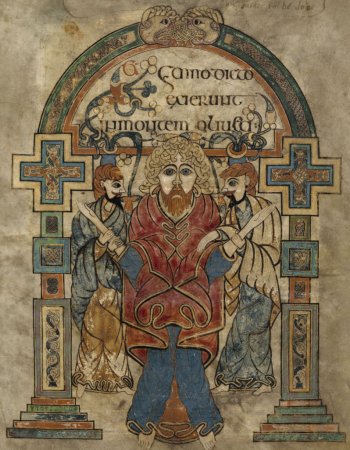
The Arrest of……Christ ( Folio 114r)
The Most Beautiful Book in the World The Book of Kells
Let me begin by saying that The Most Beautiful Book In The World, The Book of Kells, is actually not even a book at all. It is a codex, which is in essence pieces of paper or vellum that are stack up. This method was the precursor of the book and was one step up from the scroll. But for this post it shall be referred to as a book.
History
Many say The Book of Kells could only have been written by angels. To lay the groundwork of why this is we must go back to the 6th century and look at the life of a man, Colum Cille or Chille (meaning “The Dove of the Church”) also known as St. Columba to the Latin speaking world. Around the year 561 Saint Columba traveled to Dál Riata in Scotland, with twelve companions, as a pilgrim for Christ after being exiled from Ireland for a disagreement that had led to the Battle of Cúl Dreimhne which resulted in several lost lives. In 563 he settled on Iona, an island off the west coast of Scotland and set up the monastery at Iona. Thus began the foundation of the Irish Mission System. The monastery at Iona helped establish several other monastic houses including those at Derry, Durrow and Lindisfarne.
It is generally believed by scholars that The Book Of Kells, a text of the Gospels, was created by monks on Iona sometime between 750 and 800 based on paleographic research and stylistic grounds. The monastery was attacked by Vikings in 795 and burned to the ground in 802. In 806 another attack resulted in the deaths of 68 of the brothers. The numerous battles and loss of life may account for why the illuminated manuscript was never finished.
The Book Is Moved
In 807 a portion of the monastic community moved to Kells for safety. A new abbey was completed at Kells in 814. In 878, following another attack on Iona, the shine of Colum Cille and other relics were moved to Kells. It is unknown whether The Book of Columba was moved at this time as it was not formally mentioned until 1007 when it was referred to as “the great gospel of Colum Cille” when a record of its theft was mentioned in the Annuals of Ulster. The book was found buried under sod and stripped of its gold cover two months and 28 days later. It is believed by scholars that when the book was forcefully stripped of its cover several pages (30 folios) were also torn and lost. Sometimes around 1621 James Ussher, archbishop of Armagh, referred to the relic of Colum Cille as “The Book of Kelles”. From that time on it was known as The Book of Kells.
By the 1600’s the Abbey at Kells was almost in ruins. During the Cromwell period the monastery suffered even greater damage. The decision was made to send The Book of Kells to Dublin for safekeeping. Around 1661 Henry Jones, the Bishop of Meath, presented The Book of Kells to Trinity College where it has remained ever since. It has been at the Old Library since the 19th century. In 1821 the pages of vellum were cropped in a misguided attempt at rebinding and this damaged a few illuminations in the process.The manuscript was bound into four volumes for each of the gospels: Matthew, Mark, Luke and John In 1956. In 1986 the publishers Faksimile-Verlag of Switzerland created 1480 copies of The Book of Kells. Trinity College produced a digital copy in 2006. In this present day and age The Book of Kells can now be viewed on an iPad via a downloadable App.
Who Is The Author/Artist?
One of the great mysteries of The Book of Kells is who is actually responsible for creating this work of art.
I. Scribes
Various experts believe that there were three to four scribes working on the manuscript based on the minor variations found in text and artwork. Francoise Henry named the scribes A., B., C. and D. It is believed that the scribes were all trained in the same scriptorium Insular style also known as Hiberno-Saxon art. Scribe A. has been characterized as sober and conservative. The preliminary texts and Mark’s Gospels have been attributed to him. Scribe B. had an affinity for the colors purple, red, black and yellow. He is responsible for completing the canon tables, Matthew’s Gospel among other works. Scribes C. and D. are difficult to distinguish from one another. It is not known whether or not they worked on the book in unison or at different intervals.
II. Artists
It was again famed French historian Francoise Henry who gave names to the three main artists responsible for the artwork in The Book Of Kells. The first was “The Goldsmith”. He was so named due to his fondness for yellow and an artistic style reminiscent of that found in Celtic jewelry and metalwork. Some works attributed to the Goldsmith are the Chi Rho, folio 34r and The Eight Circle Cross, folio 33r and several others. Next is “The Illustrator” who worked on the Arrest of Christ, folio 114r and The Temptation of Christ, folio 202v. Lastly, was “The Portrait Painter” who worked on the portrait of St. John, folio 291, Christ Enthroned, folio 32v and many others.
Christ Enthroned, folio 32 v

Physical Features of the Book
The Book Of Kells contains 340 folios (or 680 pages). It is thought that at one time the book may have contained 370 folios. The pages measure approximately 13” x 9 ½”.The Latin translation is from the Irish family of the Vulgate which was the work of St. Jerome who was commissioned by Pope Damasus (papacy 366-384).
I. Vellum
The book is made of vellum, also known as calf skin. The calf skin was washed in lime to preserve the whiteness. Afterwards it was washed in water. A blunt knife was used to scrape off the excess hair, fat and other blemishes. The skin was then dried under tension until it was ready for use.
II. Tools
An assortment of brushes, pens and knives were used to create the text and art. Paint brushes were often made with a carved wood handle and the tips would feature the hair of various animals selected for softness and volume. Pens were made from goose and swan feathers. Other possible tools used were metal compasses, rulers made from wood and bone, rock crystal used for magnification of minute work and inkwells made from cow horns. (Such an inkwell was shown in folio 291v near the foot of St. John.)
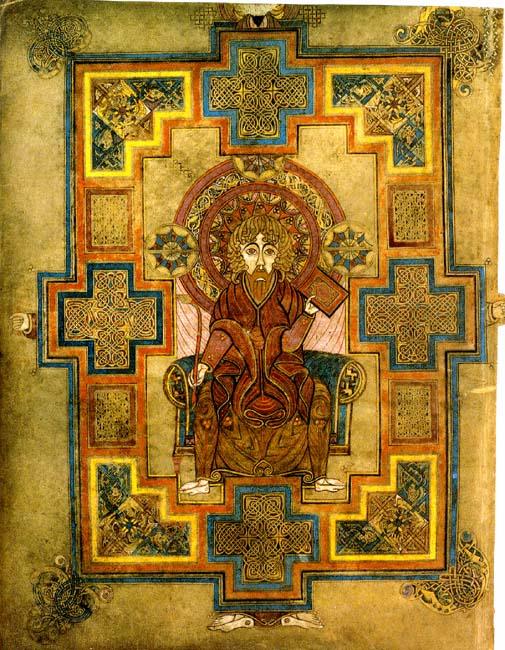
III. Ink
The ink used (and how it was created) in The Book of Kells has long been a mystery. As science has progressed so too has the knowledge of what plant and mineral extracts were collected and how they were transformed to create the ink used in both the calligraphy and artwork. The first findings were reported by W.N. Harley in the late nineteenth century. For the past fifty years there have been three major studies. The findings by H. Rosen-Runge and A.E.A. Warner in 1960 were made using a low power polarizing light microscope. Their findings included approximately twenty eight different pigments as well as a number of pigment mixes. They included such material as white lead, red lead, malachite (green), and orpiment (bright yellow). The scientists believed that the Kermes pink red was created by the dried eggs of beetles living on an oak tree which grew in the Mediterranean. Blue by far was the most difficult color to obtain in medieval times. The theory was the ultramarine shade was created from lapis lazuli which would have been found at the time only in the low hills of Afghanistan. This of course raised the question of “How on earth did monks in Scotland/Ireland acquire such material stone?” For some individuals this was a “sign” that only angels could have written the book. Another interesting object of note, the scientists concluded that the pigments used in The Book of Kells were almost identical to those used in the Lindisfarne Gospels. The most recent results (and thus far the most conclusive) were researched by a team at Trinity Collage led by Susan Bioletti in 2004 and 2006. They used micro-Raman spectroscopy with two separate laser wavelengths. Over 681 separate sites were analyzed. Their findings which differed or were in addition to the 1960 report included orcein (purple) and most notably it was found that of the 106 areas of blue that were tested, all but four of the sites contained a variety of indigo which would have been locally grown. The remaining four sites were inconclusive. As for aquamarine, if woad (blue) and orpiment (bright yellow) are mixed together it can create a lovely aquamarine shade. Indeed the results revealed that a simple range of colors could be created from sources that were fairly local. It was also determined that egg white was used as the binding medium. It should be noted that there is still a mystery with some of the colors, such as pink and a yellow brown. As science progresses there is no doubt that additional research will be made.
Noteworthy Pages
or When it gets good and REALLY interesting!!!
The Book of Kells features thirty four fully decorated pages. Many of the pages are filled with mythical beasts and Christian symbolism such as the snake, peacock, lion and fish. While each page can easily be classified as a beautiful work of art, a few are truly notable.
Remember these images were created in the 7th or 8th century with very little tools and all the color came from ink which had to be made from plants and minerals.
The Four Evangelists, folio 27v
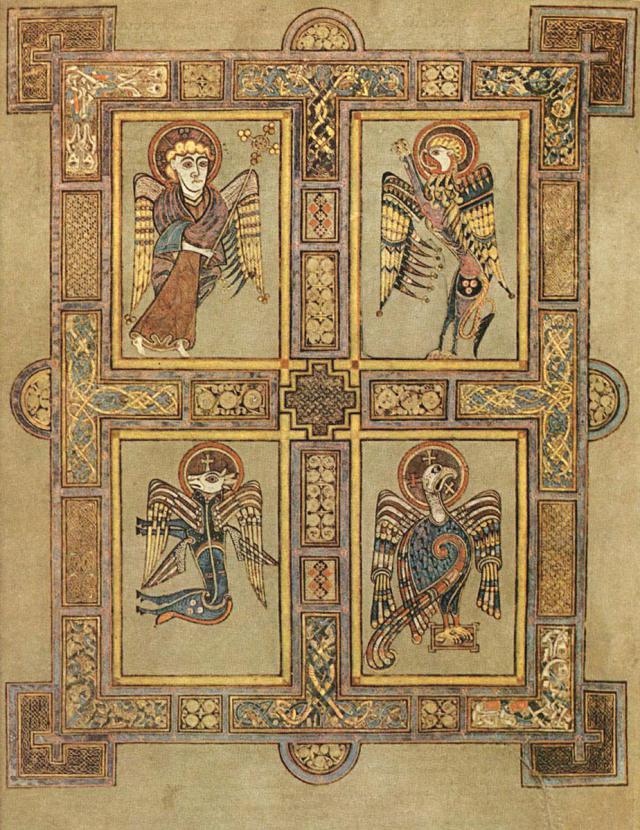
An explanation of what you are looking at.
In framed panels created in the form of a cross are symbols of the four evangelists. St. Matthew is shown as a man, St. Mark is a lion, St. Luke is a calf (or ox) and St. John is an eagle. All have haloes and wings. This symbolism is in reference to the fourth chapter of Revelation, versus 7 and 8 “the first living creature like a lion, the second living creature like an ox, the third living creature with the face of a man, and the fourth living creature like an eagle in flight”. The beasts are also mentioned in the old testament of Ezekiel 1:8-24. In the center of the four panels is a stepped cross. St. Matthew holds a flabellum (a fan used in the Catholic liturgical ceremony that is intended to keep away insects from the consecrated Body and Blood of Christ and from the priest) while St. John holds the gospel in his talons.
The Temptation of Christ, folio 202v
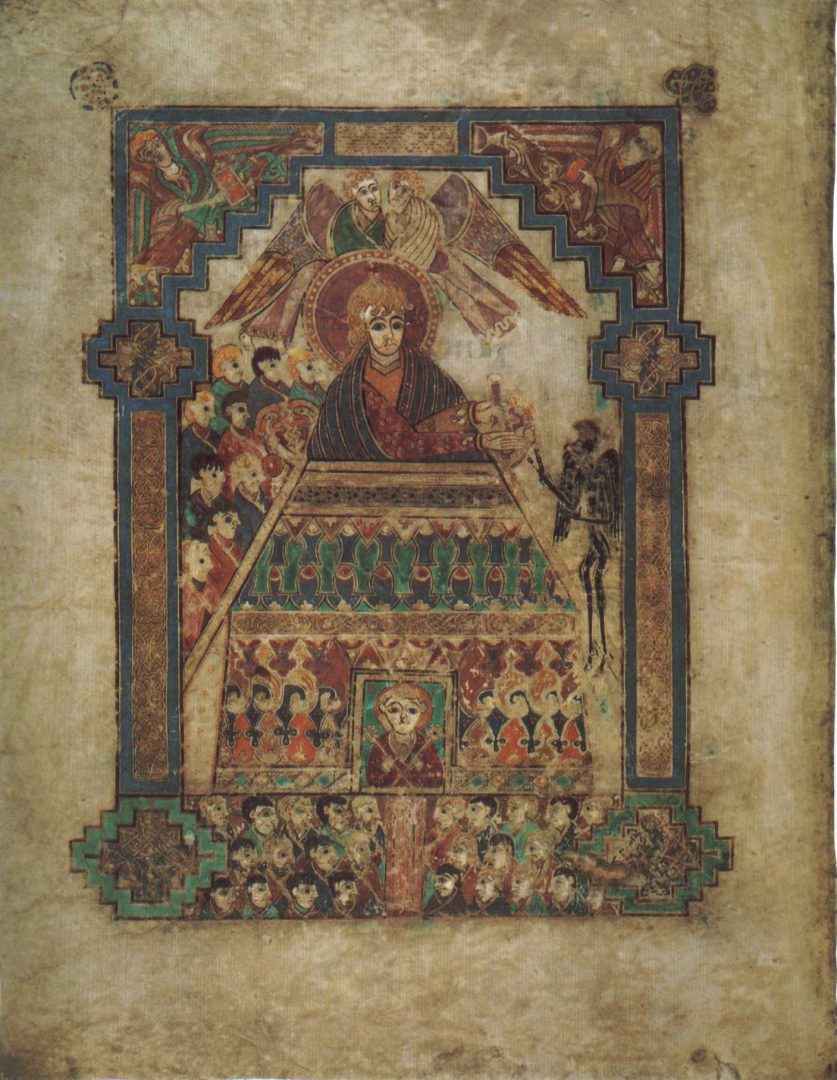
The Temptation of Christ
This folio titled The Temptation of Christ is an image that follows the verse from Luke, 9: 9-13 (And he took him to Jerusalem and set him on the pinnacle of the temple and said to him, “If you are the Son of God, throw yourself down from here, for it is written, “‘He will command his angels concerning you, to guard you,’ and “‘On their hands they will bear you up, lest you strike your foot against a stone.’” And Jesus answered him, “It is said, ‘You shall not put the Lord your God to the test.’” And when the devil had ended every temptation, he departed from him until an opportune time.” ) Jesus is shown on top of a temple roof stylized like an Irish shrine. Two angels are shown above him. Jesus holds a slender glass, perhaps a chalice of wine, to a small, winged black figure (Satan) on the right. Thirteen figures are at the foot of the page and nine figures are on the left of Jesus who are said to represent the faithful. Stylized peacocks (a symbol of immortality) are shown within crosses on either side of Jesus.
Folio 7v The Virgin and Child

The Virgin and Child
The Virgin and Child has been noted as the oldest image of Mary still in existence in a western manuscript. Surrounding Mary and the Christ child are four angels, who could possibly be Michael, Gabriel, Raphael and Uriel. The base of the throne upon which Mary sits is decorated with crosses. On the back of the throne is a lion’s head which can be interpreted as a representation of Christ. Her garments are in various shades of purple, a color long associated with royalty. The series of white triple dots on the fabric is a Far East influence where the motif was used for the finest garments. It could also be a symbolic representation of the Trinity. The broach worn on her mantle (cloak) is a lozenge (diamond) shape which is symbolic for fertility. In the lower far right are six profile heads that look to the right. This indicated that the message should be read in conjunction with folio 8 r that faces it and announces Christ’s birth.
Chi Rho
The most famous image associated with The Book of Kells is:
Chi Rho, folio 34r
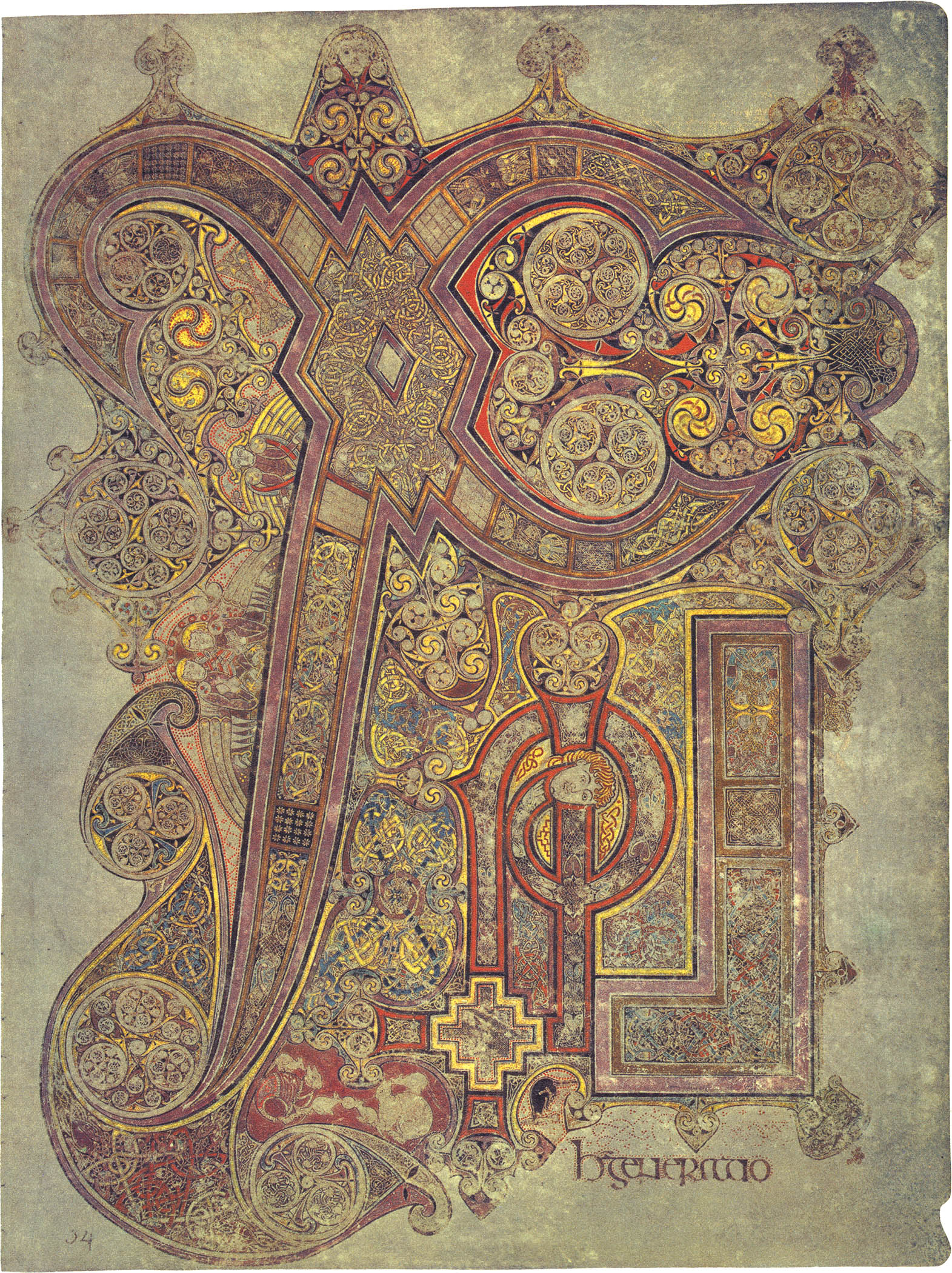
The Chi Rho monogram page marks the opening of Matthew. As with so many of the other images, the page was created in the form of a coded text to be read by the educated and not a visual text for the illiterate. Chi Rho (pronounced kai-roe) is the Greek abbreviation for Christ. (Chi = X and Rho = P) It is also is sometimes written as XPI. The “X” is the largest element on the page. The “P”, quite a bit smaller, is located underneath it. In the center of the “P” there is an “I” for the Greek letter Iota. Not as easily seen are the letters “INNITIUM” which translates to “the beginning” a reference to John 1: 1-14 “In the beginning was the Word, and the Word was with God, and the Word was God…. 14 And the Word was made flesh, and dwelt among us, (and we saw his glory, the glory as it were of the only begotten of the Father,) full of grace and truth.” A closer look at the page reveals angels and moths, a black otter with fish, and cats and mice. These symbols have been interpreted as creatures of the air/heavens, creatures of the water, and creatures of the earth.
All the work was done with a quill, brush and inks made from plants and minerals.
Are you amazed yet?
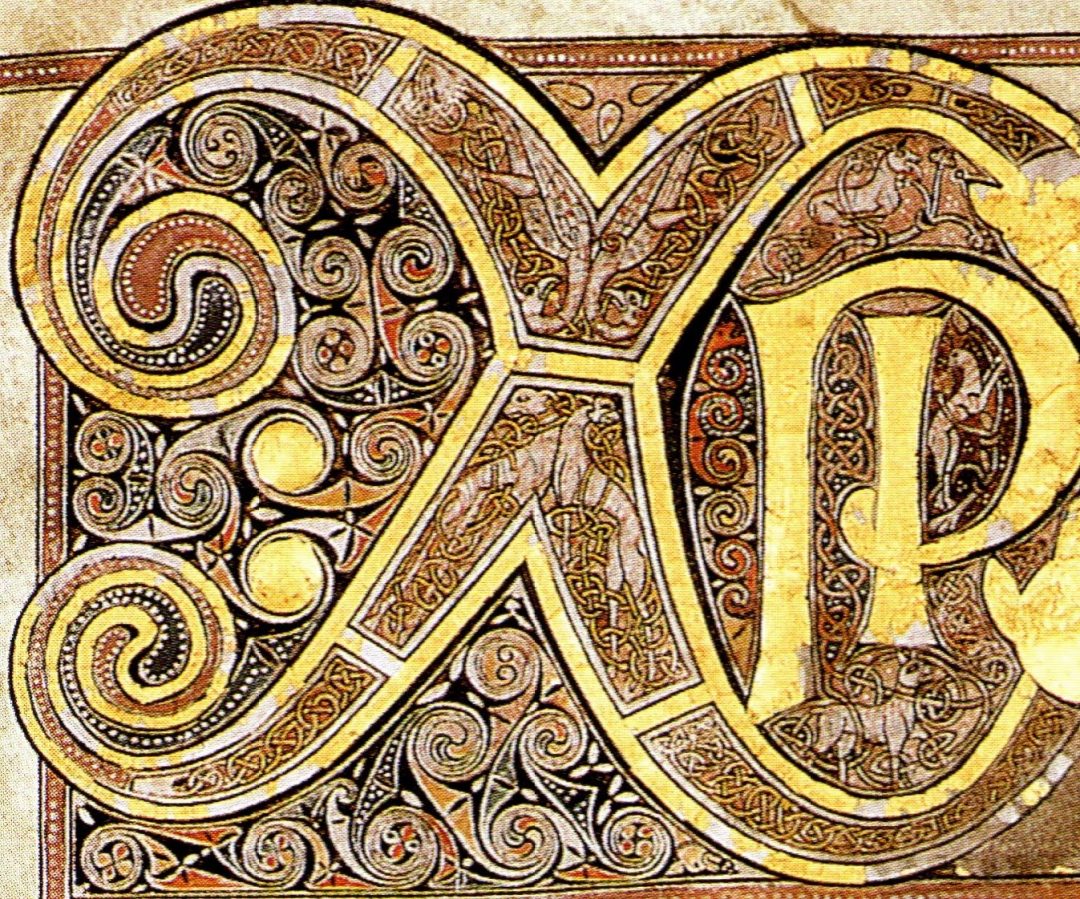
Curiosities and Fun Facts
Some of the elements of decoration in The Book Of Kells can only be seen if viewed upside down.
All of the pages, with the exception of two (29v and 301v), have some sort of decoration. But even on these two pages there are outlines of red lead dots that indicate they were to be embellished. This of course raises the question, “Why was it left unfinished?” Were men running for their lives, clinging to precious pages while leaving tools and ink behind?
James Joyce’s masterpiece “Finnegans Wake” is filled with references to The Book of Kells which Joyce viewed at Trinity College.
There are errors in The Book Of Kells. Most are minor spelling mistakes made by the scribes, but there are also entire words omitted from translated text. Others are drops of ink in minute sections in some of the artwork. These imperfections offer the proof for many that angels could not have written the book, but only mere men.
Instead of a hyphen the scribes would use a decoration of a bird or animal with the last letters written above or below. This was to save space on the vellum. The term for this is “head under wing” or “turn in the path”. An example can be seen on the third and fourth line in folio 309 r.

Still A Mystery
Although there have been numerous studies on The Book of Kells by some of the world’s most educated minds, using the most advanced tools, there still remains many mysteries, as well as differences of opinion, surrounding the book.
In the end it is perhaps easier to reflect on and consider that even with the limited tools available at the time, somehow, one of the most beautiful examples of medieval Christian art, or rather one of the most beautiful works of art ever, was created. Add onto this that the book survived at all, through truly turbulent times, can only be considered miraculous. Due to this the faithful can always choose to believe that The Book Of Kells was written by angels.
Today I’ll be giving my mind a rest and planting my roses but gearing up to write yet another research paper tomorrow. May your day be blessed and full of beauty.
Laura
Congratulations on your well-deserved A! What a relief indeed! The Book of Kells is fascinating, isn't it? My daughter does Irish Step Dancing and once they reach their third year, they get to wear the velvet dress for the big shows starting around this time of year. The hand embroidered designs that we put on the girls' dresses all come from The Book of Kells. They are quite intricate and beautiful. Thanks for sharing some insight into this historical book!
MGM
Congratulations on your A! I know the feeling of relief when one has put forth the time and effort to be rewarded with success. Sounds like a great course.
The Book of Kells is gorgeous. Beautiful post.
I'm truly proud to say
I actually saw the “Book of Kells”
It was to look at only but
sent chills down my spine knowing
how old it was and the content.
Congratulations on your A. Must
have been quite a feat to do that
well.
Sandy
Congratulations on your A. You've worked so hard and really deserve it! Thanks for the wonderful information on the beautiful Book of Kells.
Congratulations – well deserved!
I am lucky to have seen the Book of Kells in person, years ago. It is truly a masterpiece!
I did not know anything about The Book of Kells. You have done a magnificent job. Thank you so much for this post. Ann
You never cease to amaze me!
I'm glad your profs feel the same.
Congratulations!!!
The Book of Kells has long fascinated me ~ your post was a lovely tribute to it!!
Great work on making that A! I really enjoyed reading about the Book of Kells. The pictures you posted are beautifully colorful. Thanks for sharing with us.
Congrats on your A!!! That is wonderful! Beautiful post!!!
By reading from this post so far, you truly are deserving of your A!!! Congratulations! I havent really finished the whole thing, savoring it more slowly thanks!
Your paper looks fabulous and I am looking forward to reading it tomorrow when I am not completely knackered.
A couple years ago we visited Colonsay island Scotland… it's 'sister' island Oransay where the stories are either (1) St Columba landed there after being exiled. Since he could still see Ireland he continued to move on… or (2) That at some time he came thru and established a priory on Oransay.
The only thing for sure is that there IS a priory on Oransay that is dedicated to St Columba! LOL
Congratulations on your grade. Beautiful post. I purchased an amazing wood carving on Etsy from Jackdolanwoodcraft, it is a “J” for my son, Jacob, and based upon the Book of Kells.
Congratulations on your A…!! These illustrated manuscripts are so amazing and gorgeous. The years of painstaking work by CANDLELIGHT…can you imagine? Amazing…
Congratulations on your well-deserved A! I have been fortunate enough to see the Book of Kells several times while living in Dublin. They used to change the pages on display. It is indeed magnificent!
Congratulations on your 'A' for your paper. And well deserved.
Maybe they didn't get if finished because like all crafters, we some times run out of steam or time and have to put a project away until we get a burst of creativity or a bit of time. Maybe they just forgot to dig it out again to finish it up. This reminds me…I have a few scrapbook pages I need to add some finishing touches to. I had better get them done..
Hi there,
Firstly, well done on the A!! What a great feeling when your hard work pays off.
You have done a lovely post on the Book of Kells. I live in Ireland and have to agree it's pretty special. It is no less spectacular is reality. As you mentioned it is housed in Trinity College Dublin and it is free to visit on St. Patrick's Day which I think is nice. Have you been to Ireland??
Sweet Auburn Life…
What a treasure to find on one of my regular blog-readings the Book of Kells! Unique, fascinating, beautiful, thank you for posting this.